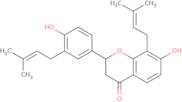Informations sur le produit
- (2S)-2,3-Dihydro-7-hydroxy-2-[4-hydroxy-3-(3-methyl-2-buten-1-yl)phenyl]-8-(3-methyl-2-buten-1-yl)-4H-1-benzopyran-4-one
- 4H-1-Benzopyran-4-one, 2,3-dihydro-7-hydroxy-2-[4-hydroxy-3-(3-methyl-2-buten-1-yl)phenyl]-8-(3-methyl-2-buten-1-yl)-, (2S)-
- 4H-1-Benzopyran-4-one, 2,3-dihydro-7-hydroxy-2-[4-hydroxy-3-(3-methyl-2-butenyl)phenyl]-8-(3-methyl-2-butenyl)-, (2S)-
- 4H-1-Benzopyran-4-one, 2,3-dihydro-7-hydroxy-2-[4-hydroxy-3-(3-methyl-2-butenyl)phenyl]-8-(3-methyl-2-butenyl)-, (S)-
Glabrol is a glycyrrhiza species that is used in Chinese herbal medicine. It has been shown to have inhibitory properties against gamma-aminobutyric acid (GABA), and also has a hypoglycemic effect. Glabrol is derived from the dried roots of Euchresta japonica, which has been shown to have anti-inflammatory, antimicrobial, and anti-fertility activities. The chemical structures of glabrol include p-hydroxybenzoic acid and fatty acids with ursolic acid as its main component.
Glabrol can be used as an alternative treatment for diabetes mellitus, although it may have some side effects such as hemolytic activity or other adverse effects on the liver or kidneys.





